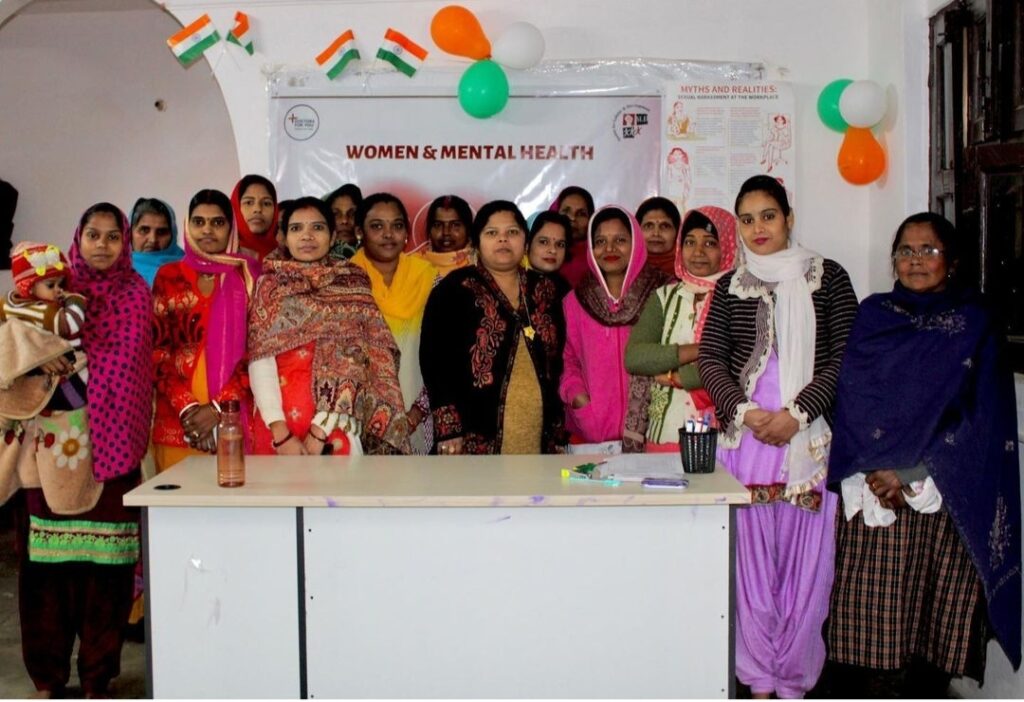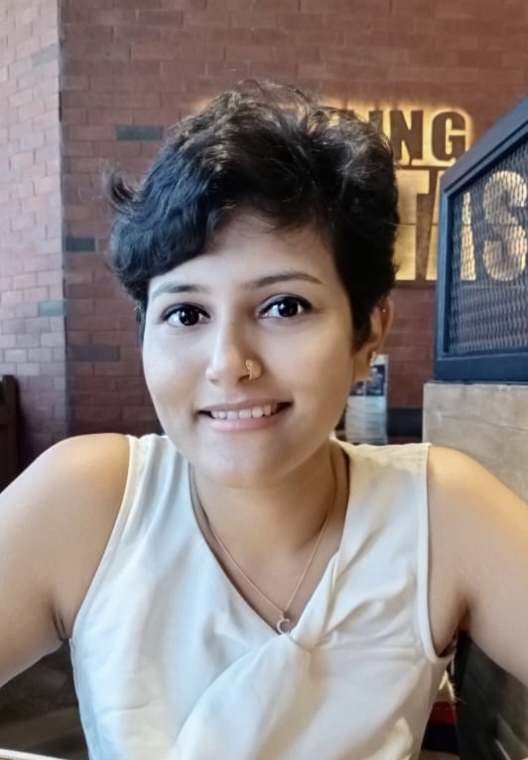Now Reading:
Strong Women, Strong Voices: Interview Series with Our Economic Security & Opportunity Partners
November 10, 2023
Interview with Ashmita Sharma — Society for Labour & Development (SLD) India
The mission of the Society for Labour and Development (SLD), led by Ashmita Sharma, is to help build a democratic and just society that is free from economic exploitation and social discrimination, with a focus on the rights of workers and marginalized people. In the pursuit of that mission, SLD, headquartered in New Delhi, India, maintains five core areas of work:
- Social and economic welfare and the wellbeing of working people
- Migrants’ rights and urban development
- Women’s voices and participation
- Cultural renewal among disenfranchised and working people
- Building a broader social movement
Founded in 2006, SLD now works across seven states in India. In August, we interviewed Ashmita to learn more about SLD’s work.
Thank you for joining us today, Ashmita, and for SLD India’s partnership with WomenStrong. We wanted to start off the interview by asking you about your own journey. What drew you to SLD India? What issues were the most important to you? And what led you to your role as Executive Director?
Ashmita: Thank you for your question, and I’m thrilled to be here today having this discussion. I have a Master of Philosophy degree in Women’s Studies from the Tata Institute of Social Sciences in Mumbai, a premiere institute in the field of social sciences. Women’s Studies is a subject that has always been dear to my heart, towards which I endeavor to do my bit to meaningfully contribute towards society.
Mainstream subjects, like history, mathematics, etc., trace their roots to antiquity. Women’s Studies is a relatively new discipline, which grew directly out of the women’s movement in the 1970s. As a response to the many systemic inequities in higher education and society, the goal of Women’s Studies is not merely to study the position of women in the world or in society, but to change it. It is with this motivation that I came to SLD.
Our work at SLD, actually, is informed by an intersectional methodology – primarily the intersections among gender, labor, and migration in numerous industries in the global supply chains, as well as some informal sectors, such as domestic work. In the thematic areas of labor education, gender-based violence, migrant workers’ rights, the global production network, the leather and seafood processing industries, we have also done a lot of action-research with an aim to better the lives of millions. These are challenging terrains which ultimately contribute towards building a broader social movement where the rights of workers and other marginalized groups are protected and respected.
Blending theory and practice is the cornerstone of the women’s movement, and the purpose of our work in SLD is also to map and understand the entire global value chain and draw lessons for the working-class movement and the women’s movement in India in order to drive research and advocacy.
Regarding your last question about my role as the Executive Director: When I was offered the position, I was both elated and overwhelmed. My first reaction was, “Do I feel like I am in a position of power? Do I feel powerful?” No, not at all. Instead, I felt a greater sense of responsibility and accountability towards the organization and my colleagues.
After assuming the position, I started thinking, “What would leadership look like for me?” As a woman leader, I thought it was very important that I create safe space for my colleagues at SLD. This can happen only by sharing power, co-creating ideas, building self-reflection, and ensuring [that] collaborative decision-making is used in all organizational processes.
According to SLD’s website, the organization has touched the lives of around 10,000 people employed in different sectors of the Indian economy. Since you started working at SLD India, what is one specific example of how the organization has made an impact?
Ashmita: Firstly, I would like to provide a little background to the kind of work that we do in SLD. We believe in implementing impactful interventions through collective action and knowledge building, where we take a very qualitative approach. Our methodology draws from the lived experiences of workers in the community and knowledge from the field. We’ve also believed in and implemented a bottom-up approach for the past 17 years.
Our longstanding work in the global supply chain industries is very important in the garment, leather, seafood, and in the informal sectors that we work in. This overall intersection is very significant, considering we have workers from different industries and diverse sociocultural groups. The intersection between gender and labor comes into play when we analyze different situations in the workplace — in the community, or at home — also when we try to link and draw a continuum among these three domains of work.
Collective action and community-based work, when they occur concurrently, facilitate the growth of leadership and workplace voice. Without collectivization, it is difficult to access voice at work, and the fear of losing one’s job in these industries makes it difficult to access grievance mechanisms. To address this, SLD is working towards creating an enabling environment for social dialogues between workers and management on the challenges facing workers – with an increased focus on having insightful conversations about the advantages and gaps in existing grievance processes.
We started out by using collective action to intervene in the garment industry, but over time, we’ve gradually expanded to other important supply chain sectors. SLD’s strategic focus places a strong emphasis on this intersectional work, which includes both community-based interventions and research into new organizing methods. By “new organizing methods,” I mean, “attempting strategies and methods of organizing that are primarily sector-based by supporting new types of workers’ collectives or organizations to develop in industries.” It is important to try to organize by using new strategies, such as through global supply chains. Having said that, we also closely work with industry stakeholders to support implementation of best practices in their global supply chains.

SLD’s services are specifically focused, as you said, on workers, primarily women, in the garment, leather, and seafood processing industries. What roles do women have in these industries, and what are the challenges they face?
Ashmita: So, women in these industries are mostly confined to the production spaces. I mean, we know that women are considered cheap labor. Therefore, they are mostly confined to these very specific skill-based jobs in these different industries. Even though we are working in different industries of the global supply chain, which are so-called formal spaces, there is a great deal of informality in the formal sector, whether it’s leather, seafood, garment-manufacturing — whatever you call it. A large number of workers are engaged in informal spaces as home-based workers, contractual workers, daily-wage workers, piece rate workers, who on the one hand contribute to the formal sector, but they’re not visible as part of the formal workforce. Their labor is largely devalued and made nearly invisible.
Additionally, there are extended working hours and unrecorded overtime, unrealistic production targets, illegal terminations, lack of severance pay, extremely low wages, and the like. Most women workers are hired on a temporary basis. There are no formal, stable work contracts, no living wages, etc.
Women workers in the garment, leather, and seafood processing industries are hired through recruitment intermediaries, who are contractors or subcontractors. These women workers do not have any direct employment relationship with the factories. Subcontracting is an illegal act even in the company’s rule books, but subcontracting as a practice is rampant. This puts home workers in an even more disadvantageous and vulnerable position, where they’re not able to raise their concerns with contractors or do not even know who their principal employers are. So, we see that employment relationships, even within formal work spaces, are highly unregulated and informal.
There is also a strong push from the global supply chains, who are our major stakeholders in these organized spaces, and they’ve made rigorous efforts to meet compliances. This also has an impact on their brand value and stature in the competitive environment, but the question is: is it only about meeting compliances, or meaningful compliances, in terms of ensuring responsible business in practice? So, my ask is, do brands recognize sexual harassment, for instance, as a human rights risk?
To this point, in a recent joint study carried out in India by SLD, Asia Floor Wage Alliance (AFWA), and Business and Human Rights Resource Centre (BHRRC), we interviewed women in 31 factories across India who reported that they had witnessed or experienced supervisors or managers committing gender-based violence (GBV) and harassment in their factories. GBV in the workplace is a serious human rights violation. According to the UN Guiding Principles on Business and Human Rights, businesses are responsible for identifying and preventing human rights risk in their supply chains. Companies primarily depend on internal codes of conduct and social audits to tackle and keep track of GBV in their supply chains. But our experience shows that such voluntary standards or methods are inadequate to prevent GBV in the supply chains. These are some of the overwhelming issues that directly or indirectly impact women workers in the global value chains.

What does growth look like for women in these industries? Are the barriers they face, like those you mentioned, insurmountable, or are you seeing change in the industries?
Ashmita: As I said, women are mostly confined to the production spaces. Upward mobility in the occupational hierarchy looks like a huge barrier for these women workers. You will hardly find women supervisors or women managers, and intersections of class, caste, gender have a huge role to play in obstructing women’s mobility in these occupational spaces.
With recent regulations and the Guiding Principles on Business and Human Rights, you don’t [actually] see the change in the brands’ approach towards the issue of human rights. But what is worth mentioning is that they have at least started recognizing our efforts — or the efforts of worker collectives and other stakeholders in the civil society spaces who are working towards improving wellbeing of the workforce in the supply chains. Today brands are willing to participate in discussions about how a certain business model and purchasing practices impact working conditions.
There’s also SLD’s intervention in terms of training and capacity-building of workers to facilitate their voice at work. We are seeing that women workers have started opening up, by identifying different forms of violence that exist in the workplace, public spaces, and in their homes, which were otherwise normalized. For example, mental harm was never recognized as a form of violence, but because of our training initiatives and leadership development, women have started recognizing these as serious forms of violence and have shown interest in coming together to share experiences, to collaborate, and to network and explore their sisterhood. This is where SLD’s “Workers’ Café” intervention has played a significant role. Through the Workers’ Café, we offer women and other members of the community a safe space to express themselves. The cafe approach intends to be interactive, inclusive, and collaborative, giving all participants a chance to voice their ideas and opinions without any fear.
>>>Continue Reading This Interview Here
About Ashmita Sharma:

Ashmita earned her Master of Philosophy degree in Women’s Studies from the Tata Institute of Social Sciences in Mumbai and received the Professor Chhaya Datar Award for her research, “Experiencing Widowhood in Vrindavan.” Prior to her role as Executive Director at SLD India, Ashmita served as Lead for Research, Training, Communication. Before moving to SLD India, Ashmita served as a curriculum developer in the Ministry of Human Resource Development (MHRD). Ashmita’s work is focused on the interdisciplinary perspectives of gender and labor, and she has contributed to numerous journals on the subject. Through her work, Ashmita aspires to reach large audiences, not only to improve the working conditions of workers, but also to bring about cordial and mutually respectful relationships between workers and industries.
More About the Society for Labour & Development (SLD) India:
SLD India was founded in 2006 under the Indian Trusts Act, a law in governing private trusts and trustees. The Act was established at a time of rapid growth around India. While wealth and prosperity grew exponentially, these benefits were not trickling down to the working class and socially disenfranchised communities. Very often, these communities were deliberately denied basic human and civil rights. It was in this atmosphere that SLD India was established to support initiatives for labor rights and human rights. For more information, please visit SLD’s website: https://www.sld-india.org/.
Related Blogs and Stories:

